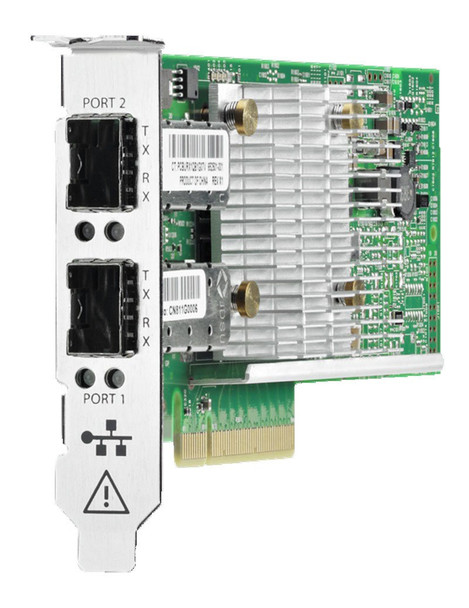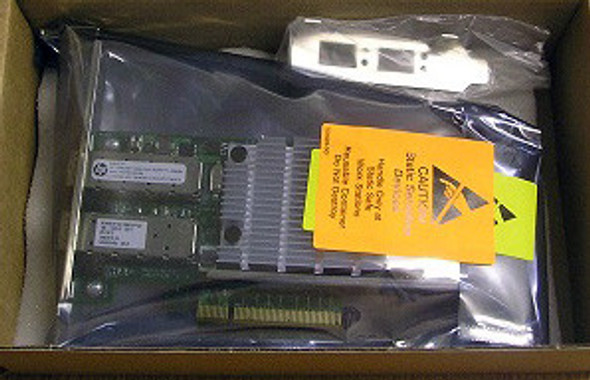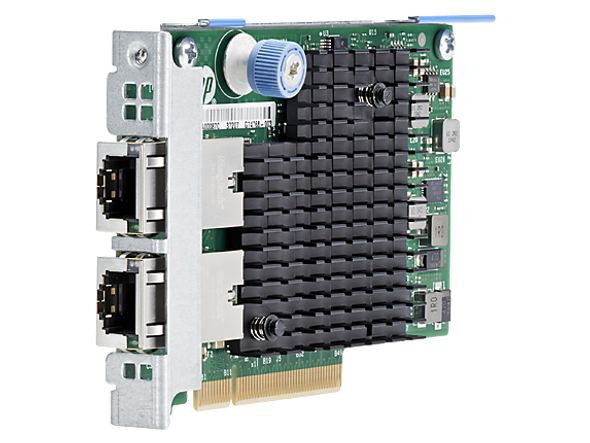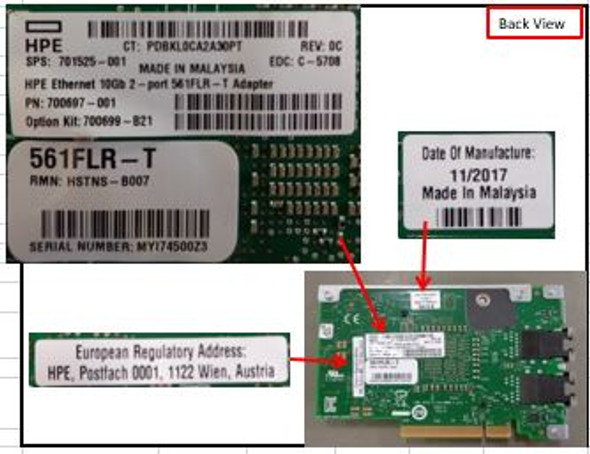HP
HPE 652503-B21 10GbE 2-Port 530SFP+ Adapter for G7 G8 G9 G10 Servers
- SKU:
- 652503-B21
- UPC:
- 886111577644
- MPN:
- 652503-B21
- Condition:
- New
- Availability:
- In Stock - Ship Same Day
Description
HPE 652503-B21 10Gb Ethernet Dual-Port PCI Express 2.0 x8 530SFP+ Network Adapter with both Brackets for ProLiant Gen7 Gen8 Gen9 Gen10 & Apollo Gen9 Servers (New Bulk Pack with 90 Days Warranty)
The HPE 652503-B21 530SFP+ is a dual-port 10Gb Ethernet Adapter in a PCIe 2.0 compliant form factor designed for select HPE ProLiant Gen10, Gen9, Gen8 and Gen7 ML/DL/SL Servers. Leveraging HPE’s market-proven architecture and software, the HPE 530SFP+ delivers full line-rate performance across all ports with low power consumption. Support for Hewlett Packard Enterprise Sea of Sensors 3D Technology enhances server performance while reducing energy use and expense. The HPE 530SFP supports enterprise class features such as VLAN tagging, adaptive interrupt coalescing, MSI-X, NIC teaming (bonding), Receive Side Scaling (RSS), jumbo frames, PXE boot and virtualization features such as VMware NetQueue and Microsoft VMQ. This HPE 530SFP+ Dual-Port 10Gb Ethernet Adapter comes with both brackets (Full-Height Bracket and Half-Height Bracket) and has 90 Days Warranty.
Specifications
Brand: HPE
MPN: 652503-B21
Option Part Number: 652503-B21
Spare Part Number: 656244-001
Assembly Number: 652501-001
General Specifications
Device Type: Network Adapter (with both Bracket)
Form Factor: Standard and Low Profile Adapter Compliant with the PCIe Standard
Network Processor: Cavium 57810S chipset
Data Rate: Two Ports, each at 20Gbps Bi-Directional; 40Gbps Aggregate Bi-Directional Theoretical Bandwidth
Onboard Memory (Interface Type): PCI Express 2.0 (Gen 2) x8
PCI Specification Revision: PCIe 2.0
Included Accessories: Low-Profile Bracket, Full-Height Bracket
Networking Specifications
Connectivity Technology: Wired
Data Link Protocol: 10 GigE
Data Transfer Rate: 10 Gbps
Features: IPv6 Support, Jumbo Frames Support, Teaming Support, PXE Support, Large Send Offload (LSO), Receive Side Scaling (RSS), TCP Segmentation Offload (TSO)
Ports: 10Gb Ethernet x 2
Remote Management Protocol: SNMP
Status Indicators: Port Status, Link/Activity
Power Specification
Power Consumption: 9Watt Maximum
Environmental Specifications
Temperature - Operating: 0° to 55°C (32° to 131°F)
Humidity - Operating: 5% to 95% Non-Condensing
Processor / Memory
Processor: 1 x BCM57810S - Broadcom
RAM: 256 MB
Expansion & Connectivity
Compatible Slots: 1 x PCI Express 3.0 x8
Interfaces: 2 x 10Gb Ethernet - SFP+
Product Dimensions & Weight
Width: 9.50 inch
Height: 2.25 inch
Depth: 7.50 inch
Weight: 1.00 lbs
Software / System Requirements
OS Required: SuSE Linux Enterprise Server 11, Microsoft Windows Server 2008 R2, SuSE Linux Enterprise Server 10, Microsoft Windows HPC Server 2008, Microsoft Windows Server 2008 (32/64-bits), Oracle Solaris 10, Red Hat Enterprise Linux 6.1, Red Hat Enterprise Linux 5.7
Compliant Standards
IEEE Compliance: 802.3, 802.3ae, 802.3x, 802.2x, 802.3ad, 802.1Qaz, 802.1Qau, 802.1Qbb, 802.1Qbg, 802.1ax
RoHS Compliance: 6 of 6
Agency Approvals
USA: FCC Part 15 Class A
Canada: ICES-003, Issue 4
Japan: VCCI V3 (2010.04) Class A
International: EN55022:2006 + A1:2007 Class A, EN55022:2006 + A1:2007 Class A, EN55024:1998+A1:2011+A2, EN61000-3-2:2006, EN61000-3-3:2008
Taiwan: BSMI, CNS13438 (2006) Class A
Australia/New Zealand (AS/NZS): EN55022:2006+A12007 Class A
Korea: KN22 Class A, KN24
Compatibility Information
Designed for
HPE Apollo 4200 Gen9 Server
HPE ProLiant DL Series: DL20 Gen9, DL60 Gen9, DL80 Gen9, DL120 Gen9, DL160 Gen9, DL180 Gen9, DL360 Gen9, DL360 Gen10, DL380 Gen9, DL380 Gen10, DL560 Gen9, DL560 Gen10, DL580 Gen9, DL580 Gen10 Servers
HPE ProLiant DL Series (Rack-Optimized): DL160 Gen8, DL165 Gen7, DL360e Gen8, DL360p Gen8, DL380e Gen8, DL380p Gen8, DL385p Gen8, DL580 Gen7, DL585 Gen7, DL980 Gen7 Servers
HPE ProLiant ML Series: ML30 Gen9, ML350 Gen9 Servers
HPE ProLiant ML Series (Expansion-Optimized): ML350e Gen8, ML350p Gen8 Servers
HPE ProLiant SL Series (Scalable Line): SL230s Gen8 and SL250s Gen8 Servers
HPE Apollo XL Series: 2000-XL170r Gen9, 2000-XL190r Gen9, 4500 XL450 Gen9 and 6500 XL270d Gen9 Servers
Product Features (HPE 652503-B21 530SFP+ Dual-Port 10Gb Ethernet Adapter)
Dual-Port 10Gb Ethernet Low Profile Adapter Designed for Greater Network Performance
Ethernet transfer rate of 20 Gbps full duplex per port (40 Gbps aggregate) improves response times and alleviates bottlenecks in next generation data centers. Comprehensive stateless offloads optimize host efficiency and virtual machine density by offloading network processes from the host CPU. Virtualization support for VMware NetQueue and Microsoft VMQ to meet the performance demands of consolidated virtual workloads. Ready for SR-IOV virtualization. Support for MSI/MSI-X provides performance benefits for multi-core servers by load balancing interrupts between CPUs/cores.
Power, Performance and Integration are key to this 10Gb Ethernet Adapter
Single-chip solution integrating PHY and MAC. Up to 40 Gbps bi-directional near line rate throughput. Less than 8 watts total power dissipation.
Standard Features (HPE Ethernet 10Gb 2-Port 530SFP+ Adapter)
At a Glance Features
- Industry-leading throughput and latency performance
- Operates at 1 Gbps/10 Gbps, auto-negotiation, on both ports
- Up to 40 Gb/s bi-directional near line rate throughput
- Hardware acceleration TCP/IP/UDP stateless offloads, as well as for TCP Offload Engine (TOE)
- Improved small packet performance: Supports UEFI and legacy boot options and Tunnel offload support (NVGRE, VXLAN)
- Low profile design shipping with standard height and low-profile brackets
- Optimized for virtual server environments with support for Network Partitioning (NPAR) and Single-Root I/O Virtualization (SR-IOV)Active Health Systems support via FW (OCBB), I2C capable
- PXE, Jumbo Frames, Checksum & Segmentation Offload, IPv6 and RSS
- On chip temperature monitor (OCSD)
- Standard server operating system support
- Field replaceable and upgradeable
- Support for Preboot eXecution Environment (PXE)
- Integrated PHY and MAC
- IEEE 1588 (Time Synchronization)
Throughput-Theoretical Bandwidth
This adapter delivers 20 Gb/s bi-directional Ethernet transfer rate per port (40 Gb/s per adapter), providing the network performance needed to improve response times and alleviate bottlenecks.
802.1Q VLANs
IEEE 802.1Q virtual local area network (VLAN) protocol allows each physical port of this adapter to be separated into multiple virtual NICs for added network segmentation and enhanced security and performance. VLANs increase security by isolating traffic between users. Limiting the broadcast traffic to within the same VLAN domain also improves performance.
Checksum & Segmentation Offload
Normally the TCP Checksum is computed by the protocol stack. Segmentation Offload is technique for increasing outbound throughput of high-bandwidth network connections by reducing CPU overhead. The technique is also called TCP segmentation offload (TSO) when applied to TCP, or generic segmentation offload (GSO).
Configuration Utilities
This adapter ships with a suite of operating system-tailored configuration utilities that allow the user to enable initial diagnostics and configure adapter teaming. This includes a patented teaming GUI for Microsoft Windows operating systems. Additionally, support for scripted installations of teams in a Microsoft Windows environment allow for unattended OS installations.
Converged Network Utility (CNU)
This adapter supports Converged Network Utility (CNU) a manageability application to configure converged network adapters (CNAs) and Ethernet adapters on HPE servers. This host based utility supports for both GUI and Command Line Interface (scriptable), and can be used to configure Ethernet, FCoE, iSCSI and NPAR related features/functionality on multiple OS platforms including Windows and Linux. CNU is able to configure multiple HPE adapters from various network controllers at the same time. Users can benefit easier setup steps, shorter re-boot time, and one-stop solution for multiple adapters via CNU.
DPDK
This adapter supports DPDK with benefit for packet processing acceleration and use in NFV deployments.
HPE Sea Of Sensors 3D
Support for the HPE Sea of Sensors which is a collection of 32 sensors that automatically track thermal activity - heat - across the server. When temperatures get too high, sensors can initiate fans and make other adjustments to reduce energy usage. A significant improvement lies in the ability to apply fan speed increases only to the portion of the system that is rising in temperature, rather than all six fans in unison, which reduces the amount of energy used for cooling.
IPv6
IPv6 uses 128-bit addressing allowing for more devices and users on the internet. IPv4 supported 32-bit addressing.
Jumbo Frames
This adapter supports Jumbo Frames (also known as extended frames), permitting up to a 9,000 byte (KB) transmission unit (MTU) when running Ethernet I/O traffic. This is over five times the size of a standard 1500-byte Ethernet frame. With Jumbo Frames, networks can achieve higher throughput performance and greater CPU utilization. These attributes are particularly useful for database transfer and tape backup operations.
LED Indicators
LED indicators show link integrity and network activity for easy troubleshooting.
Management Support
This adapter ships with agents that can be managed from HPE Systems Insight Manager or other management application that support SNMP.
Message Signaled Interrupt (Extended) (MSI-X)
Message Signaled Interrupt (Extended) provides performance benefits for multi-core servers by load balancing interrupts between CPUs/cores.
Network Adapter Teaming
This adapter support for NIC teaming helps IT administrators increase network fault tolerance and increased network bandwidth, the team of adapters can work together as a single virtual adapter, providing support for several different types of teaming enabling IT administrators to optimize availability, improve performance and help reduce costs.
Network Partitioning (NPAR)
This adapter supports Network Partitioning (NPAR) allowing administrators to configure a 10 Gb port as four separate partitions or physical functions. Each PCI function is associated with a different virtual NIC. To the OS and the network, each physical function appears as a separate NIC port.
Optimized for Virtualization
I/O Virtualization support for VMware NetQueue and Microsoft VMQ helps meet the performance demands of consolidated virtual workloads.
Preboot eXecution Environment (PXE)
Support for PXE enables automatic deployment of computing resources remotely from anywhere. It allows a new or existing server to boot over the network and download software, including the operating system, from a management/ deployment server at another location on the network. Additionally, PXE enables decentralized software distribution and remote troubleshooting and repairs.
Receive Side Scaling (RSS)
RSS resolves the single-processor bottleneck by allowing the receive side network load from a network adapter to be shared across multiple processors. RSS enables packet receive-processing to scale with the number of available processors.
Server Integration
This adapter is a validated, tested, and qualified solution that is optimized for HPE ProLiant servers. Hewlett Packard Enterprise validates a wide variety of major operating systems drivers with the full suite of web-based enterprise management utilities including HPE Intelligent Provisioning and HPE Systems Insight Manager that simplify network management.
This approach provides a more robust and reliable networking solution than offerings from other vendors and provides users with a single point of contact for both their servers and their network adapters.
Single-Root I/O Virtualization
Single-Root I/O Virtualization (SR-IOV) provides a mechanism to bypass the host system hypervisor in virtual environments providing near metal performance and server efficiency. SR-IOV provides mechanism to create multiple Virtual Functions (VFs) to share single PCIe resources. The device is capable of SR-IOV, and requires Server BIOS support, controller firmware, and OS support.
TCP/UDP/IP
For overall improved system response, this adapter supports standard TCP/IP offloading techniques including: TCP/IP, UDP checksum offload (TCO) moves the TCP and IP checksum offloading from the CPU to the network adapter. Large send offload (LSO) or TCP segmentation offload (TSO) allows the TCP segmentation to be handled by the adapter rather than the CPU.
Precision Time Protocol (IEEE 1588 PTP)
Synchronization of system clocks throughout a network, achieving clock accuracy in the sub-microsecond range, making it suitable for measurement and control systems.
TOE
TCP/IP Offload Engine (TOE) shifts the processing of data in the TCP protocol stack from the server CPU to the adapter's processor, freeing server CPU cycles for other operations.
Tunnel Offload
Minimize the impact of overlay networking on host performance with tunnel offload support for VXLAN, NVGRE and GENEVE. By offloading packet processing to adapters, customers can use overlay networking to increase VM migration flexibility and virtualized overlay networks with minimal impact to performance. HPE Tunnel Offloading increases I/O throughput, reduces CPU utilization, and lowers power consumption. Tunnel Offload supports VMware's VXLAN, Microsoft's NVGRE solutions and Generic Network Virtualization Encapsulation (GENEVE) solutions.
VMware NewQueue and Microsoft Virtual Machine Queue (VMQ)
VMware NetQueue is technology that significantly improves performance of 10 Gigabit Ethernet network adapters in virtualized environments.
Windows Hyper-V VMQ (VMQ) is a feature available on servers running Windows Server 2008 R2 with VMQenabled Ethernet adapters. VMQ uses hardware packet filtering to deliver packet data from an external virtual machine network directly to virtual machines, which reduces the overhead of routing packets and copying them from the management operating system to the virtual machine.
Contact us if you have any question about this product to verify this model’s compatibility with your current server or storage array.





















